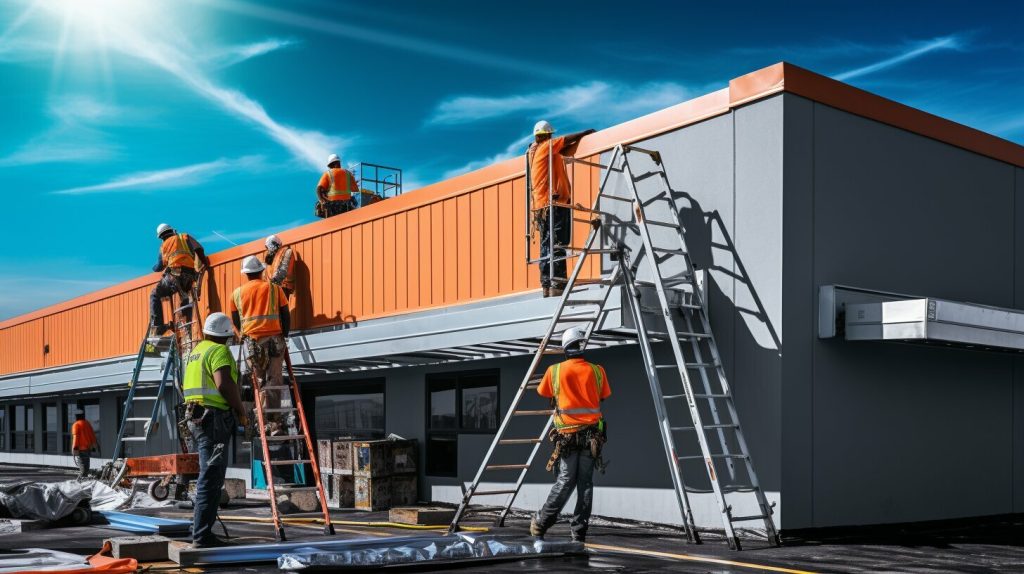An Beginner's Overview to Level Roofing vs. Sloped Roofs
Regarding roofing, property owners often face a key decision: is it better to choose a level roof or a sloped roof? Both options comes with its own set of benefits and drawbacks, making it important to carefully consider your choices. Grasping the key differences between level and pitched roofs can greatly influence not only the visual charm of your house but also its longevity, maintenance needs, and overall performance.
In this introductory guide, we will explore the fundamentals of level and pitched roofing, to guide you towards making an intelligent selection. Whether you are planning for a new roof installation or a replacement, being able to assess your current roof setup is crucial. From recognizing when it’s time for a new roofing to understanding the diverse roofing materials on the market, this guide will offer the information you need to start your roofing process. By concentrating on common roofing problems, repair options, and tips for extending the lifespan of your roof, you'll be ready to manage the intricacies of roofing.
Grasping Roof Types
Regarding roofing, two primary types are prominent: flat roofs and sloped rooftops. Level rooftops feature with their little angle, rendering them a frequent option for industrial structures and contemporary house designs. They present gains including easy access for servicing and setup of HVAC equipment. However, level roofs can be vulnerable to water accumulation if not adequately designed and cared for, hence understanding the particular roofing substances utilized is crucial in lengthening their durability.
On the other hand, inclined roofs, that include a noticeable incline, have been the standard selection for many homes. The pitch of these rooftops encourages superior flow, reducing the likelihood of leaks and detriment from pooling moisture. Additionally, sloped roofs can better resist harsh weather elements, as they aid minimize significant snow accumulation and handle air force well. Property owners often appreciate the visual attractiveness of inclined roofs, that can enhance the general look of their houses.
Deciding between flat and sloped roofs generally relies on multiple considerations including regional climate, construction form, and the specific demands of the property owner. It's important to consider these factors, together with the possibility for upkeep and maintenance, when deciding. Understanding the properties of the different roofing type can assist householders make informed choices that align with their sustained objectives for roof durability and functionality.
Crucial Upkeep and Repair Tips
Routine upkeep is crucial for both level and angled roofs to ensure their durability and performance. Residents should conduct physical inspections a few of times a year, ideally in autumn and fall, looking for signs of deterioration, missing shingles, or pooling water on level roofs. Keeping gutters and downspouts clear of debris is also essential to avoid water damage and ensure adequate drainage. Regular cleaning and upkeep of roof surfaces can help prevent costly repairs down the line.

In furthermore to visual inspections, it's important to arrange professional roof inspections every few years, particularly after severe weather events. A roof expert can detect problems that may not be visible to the layman's eye, such as underlying damage or potential leaks. Addressing these issues promptly can spare homeowners money and prolong the lifespan of their roofs. Continue Reading to roof replacement emphasizes the importance of preventive maintenance to avoid the need for premature roof replacement.
For homeowners thinking about DIY roof repairs, it is crucial to recognize their skill level and the complexity of the repair needed. Basic tasks like changing a few shingles may be doable, but more extensive repairs, particularly on flat roofs, are best left to experts. Hiring experienced roofers guarantees that repairs are performed correctly and safely, which can help prevent further complications. Understanding when to employ a professional versus doing it on your own can make a significant difference in maintaining your roof’s health.
Pricing and Setup Considerations
When considering a roof upgrade, both flat and angled roofs come with their own unique expenses and installation challenges. Generally, sloped roofs are more prevalent in home areas, potentially leading to a broader range of material options and pricing. Setup costs can vary significantly based on the roofing type chosen, such as asphalt shingles or metal sheets for a sloped roof, compared to single-ply membranes or multi-layer systems for flat roofs. It is crucial to consider both material and labor when calculating the total cost, as the complexity of the setup can impact labor costs.
Flat roofs typically require more frequent maintenance and careful consideration regarding drainage, which can affect long-term expenses. If not properly maintained, flat roofs are more susceptible to leaks and other issues that can lead to costly repairs down the line. Conversely, while sloped roofs may have higher initial installation costs due to their structure, they generally provide better water management and longer lifespans, which can result in lower long-term upkeep costs. Homeowners should consider these factors when choosing which roof style is best suited for their financial plan.
Another important factor is the potential for energy efficiency and insurance premiums. Flat roofs may offer room for solar panels or eco-friendly roofs, presenting options for energy savings and reduced environmental footprint. In contrast, sloped roofs might be favored by insurance providers due to their proven strength against extreme weather conditions. Homeowners should consult with roofing experts to assess the specific needs of their home and explore available choices that align with their budgetary and eco-friendly goals.